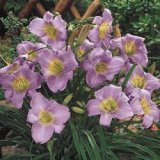Delightful Daylilies
The two best times for landscape renovation are spring and fall, but sometimes time, money and motivation for landscaping projects come together well outside these parameters. One popular perennial is resilient, hardy and perfect for transplanting from the first glimmers of spring into the dog-days of summer, and all the way up to the first hard frost. That perennial is the daylily.
|
|
Dwarf Daylily Collection |
Daylilies (Hemerocallis sp.) are no longer the lanky, orange flowered clumps normally seen growing next to drainage ditches on country roads. Hybrids range in color from the palest cream to burgundy red and red-purple. Plants come in small (24-28 tall), medium (28 36) and large (36 48) sizes, with tetraploid plants bearing supersized flowers relative to their compact size. Bloom time begins in late June in the midwest, and extends well into August. Everbloomers such as Stella dOro and her derivatives provide non-stop flowering until hard frost; reblooming varieties flower during mid-summer, then send up a second flush of flowers around October. These arent your grandmothers daylilies.
There are a number of uses for daylilies. A long, informal border of lilies provides a soft barrier between yards, or offers some privacy from the street. A more formal bed containing three to five everblooming specimen plants can provide an island of bloom in the middle of a well-kept lawn. Because lilies are exceptionally tolerant of soil types and require little to no maintenance, they can be used as groundcovers on steep banks that are difficult to mow, or as foundation plants. Daylilies can even be naturalized in dappled sun, or at the edge of a woodland garden. They may not bloom as prolifically, but the plant will still look good.
|
Border Daylily Collection |
Prairie Blue Eyes Daylily |
What gives the daylily its rugged resilience? First, the roots look like clumps of small bananas, and are strong enough to penetrate even the most recalcitrant clay. Those finger-like roots also hold water, much like a camels hump. This lets the plant survive drought. The daylily will droop and yellow after extended periods of drought, but it takes more than a few 100-degree days to kill one that is established. Second, daylilies will self-mulch at the end of the growing season. Those long, strappy leaves wither to a brown mass, which gently covers the plants root zone and prepares it for winter. Finally, daylilies are virtually disease and pest-resistant. Japanese beetle invasions can devastate roses, grapes and beds of zinnias, but daylilies will remain untouched.
You can purchase established, potted daylily plants or beg, borrow or steal (the latter isnt recommended) divisions at almost any time of the year. The main rule of planting is: make sure the hole you dig is large enough to accommodate the roots. Daylilies like to spread their toes. Other than that, no special soil preparation is needed. If you are planting during the heat of summer, be sure to water well at the time of installation and keep watering until new growth forms. If you push the envelope at the end of the season, make sure your ground doesnt freeze before the plant has a chance to establish itself, which usually takes two to three weeks.
Daylilies have cemented themselves into the American landscape, and remain one of the most popular perennials with good reason. Bargain-hunting gardeners should take advantage of the extensive daylily sales going on now through September at many nurseries and garden stores, or offer your neighbor some home-baked goodies for a few divisions. Within a few years, your plants will be flourishing happily wherever theyre planted.
| Related Articles:
Designing a Lovely Garden with Plant Stands Creating a Japanese Garden and Landscape |




